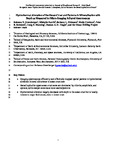Hydrothermal Alteration of the Ocean Crust and Patterns in Mineralization with Depth as Measured by Micro‐Imaging Infrared Spectroscopy
| dc.contributor.author | Greenberger, RN | |
| dc.contributor.author | Harris, Michelle | |
| dc.contributor.author | Ehlmann, BL | |
| dc.contributor.author | Crotteau, M | |
| dc.contributor.author | Kelemen, PB | |
| dc.contributor.author | Manning, CE | |
| dc.contributor.author | Teagle, DAH | |
| dc.date.accessioned | 2021-08-05T10:10:22Z | |
| dc.date.available | 2021-08-05T10:10:22Z | |
| dc.date.issued | 2021-07-15 | |
| dc.identifier.issn | 2169-9313 | |
| dc.identifier.issn | 2169-9356 | |
| dc.identifier.other | ARTN e2021JB021976 | |
| dc.identifier.uri | http://hdl.handle.net/10026.1/17392 | |
| dc.description.abstract |
<jats:title>Abstract</jats:title><jats:p>Processes for formation, cooling, and altering Earth's ocean crust are not yet completely understood due to challenges in access and sampling. Here, we use contiguous micro‐imaging infrared spectroscopy to develop complete‐core maps of mineral occurrence and investigate spatial patterns in the hydrothermal alteration of 1.2 km of oceanic crust recovered from Oman Drilling Project Holes GT1A, GT2A, and GT3A drilled in the Samail Ophiolite, Oman. The imaging spectrometer shortwave infrared sensor measured reflectance of light at wavelengths 1.0–2.6 μm at 250–260 μm/pixel, resulting in >1 billion independent measurements. We map distributions of nine key primary and secondary minerals/mineral groups—clinopyroxene, amphibole, calcite, chlorite, epidote, gypsum, kaolinite/montmorillonite, prehnite, and zeolite—and find differences in their spatial occurrences and pervasiveness. Accuracy of spectral mapping of occurrence is 68%–100%, established using X‐ray diffraction measurements from the core description. The sheeted dikes and gabbros of upper oceanic crust Hole GT3A show more pervasive alteration and alteration dominated by chlorite, amphibole, and epidote. The foliated/layered gabbros of GT2A from intermediate crustal depths have similarly widespread chlorite but more zeolite and little amphibole and epidote. The layered gabbros of the lower oceanic crust (GT1A) have remnant pyroxene and 2X less chlorite, but alteration is extensive within and surrounding major fault zones with widespread occurrences of amphibole. The results indicate greater distribution of higher temperature alteration minerals in the upper oceanic crust relative to deeper gabbros and highlight the importance of fault zones in hydrothermal convection in the lower ocean crust.</jats:p> | |
| dc.format.extent | e2021JB021976- | |
| dc.format.medium | Print-Electronic | |
| dc.language | en | |
| dc.language.iso | en | |
| dc.publisher | American Geophysical Union (AGU) | |
| dc.rights | Attribution-NonCommercial-NoDerivatives 4.0 International | |
| dc.rights | Attribution-NonCommercial-NoDerivatives 4.0 International | |
| dc.rights | Attribution-NonCommercial-NoDerivatives 4.0 International | |
| dc.rights | Attribution-NonCommercial-NoDerivatives 4.0 International | |
| dc.rights | Attribution-NonCommercial-NoDerivatives 4.0 International | |
| dc.rights.uri | http://creativecommons.org/licenses/by-nc-nd/4.0/ | |
| dc.rights.uri | http://creativecommons.org/licenses/by-nc-nd/4.0/ | |
| dc.rights.uri | http://creativecommons.org/licenses/by-nc-nd/4.0/ | |
| dc.rights.uri | http://creativecommons.org/licenses/by-nc-nd/4.0/ | |
| dc.rights.uri | http://creativecommons.org/licenses/by-nc-nd/4.0/ | |
| dc.subject | imaging spectroscopy | |
| dc.subject | hyperspectral imaging | |
| dc.subject | Oman drilling project | |
| dc.subject | oceanic crust | |
| dc.subject | hydrothermal alteration | |
| dc.subject | infrared spectroscopy | |
| dc.title | Hydrothermal Alteration of the Ocean Crust and Patterns in Mineralization with Depth as Measured by Micro‐Imaging Infrared Spectroscopy | |
| dc.type | journal-article | |
| dc.type | Journal Article | |
| plymouth.author-url | https://www.webofscience.com/api/gateway?GWVersion=2&SrcApp=PARTNER_APP&SrcAuth=LinksAMR&KeyUT=WOS:000691015100043&DestLinkType=FullRecord&DestApp=ALL_WOS&UsrCustomerID=11bb513d99f797142bcfeffcc58ea008 | |
| plymouth.issue | 8 | |
| plymouth.volume | 126 | |
| plymouth.publication-status | Published | |
| plymouth.journal | Journal of Geophysical Research: Solid Earth | |
| dc.identifier.doi | 10.1029/2021jb021976 | |
| plymouth.organisational-group | /Plymouth | |
| plymouth.organisational-group | /Plymouth/Faculty of Science and Engineering | |
| plymouth.organisational-group | /Plymouth/Faculty of Science and Engineering/School of Geography, Earth and Environmental Sciences | |
| plymouth.organisational-group | /Plymouth/REF 2021 Researchers by UoA | |
| plymouth.organisational-group | /Plymouth/REF 2021 Researchers by UoA/UoA07 Earth Systems and Environmental Sciences | |
| plymouth.organisational-group | /Plymouth/Users by role | |
| plymouth.organisational-group | /Plymouth/Users by role/Academics | |
| plymouth.organisational-group | /Plymouth/Users by role/Researchers in ResearchFish submission | |
| dc.publisher.place | United States | |
| dcterms.dateAccepted | 2021-07-11 | |
| dc.rights.embargodate | 2021-8-12 | |
| dc.identifier.eissn | 2169-9356 | |
| dc.rights.embargoperiod | Not known | |
| rioxxterms.versionofrecord | 10.1029/2021jb021976 | |
| rioxxterms.licenseref.uri | http://creativecommons.org/licenses/by-nc-nd/4.0/ | |
| rioxxterms.licenseref.startdate | 2021-07-15 | |
| rioxxterms.type | Journal Article/Review |



